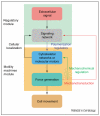Computational approaches for modeling regulatory cellular networks
- PMID: 15564042
- PMCID: PMC3619405
- DOI: 10.1016/j.tcb.2004.10.007
Computational approaches for modeling regulatory cellular networks
Abstract
Cellular components interact with each other to form networks that process information and evoke biological responses. A deep understanding of the behavior of these networks requires the development and analysis of mathematical models. In this article, different types of mathematical representations for modeling signaling networks are described, and the advantages and disadvantages of each type are discussed. Two experimentally well-studied signaling networks are then used as examples to illustrate the insight that could be gained through modeling. Finally, the modeling approach is expanded to describe how signaling networks might regulate cellular machines and evoke phenotypic behaviors.
Figures




References
-
- Hartwell LH, et al. From molecular to modular cell biology. Nature. 1999;402:C47–C52. - PubMed
-
- Lum L, Beachy PA. The Hedgehog response network: sensors, switches, and routers. Science. 2004;304:1755–1759. - PubMed
-
- Zhu H, et al. Global analysis of protein activities using proteome chips. Science. 2001;293:2101–2105. - PubMed
-
- Uetz P, et al. A comprehensive analysis of protein–protein interactions in Saccharomyces cerevisiae. Nature. 2000;403:623–627. - PubMed
-
- Ho Y, et al. Systematic identification of protein complexes in Saccharomyces cerevisiae by mass spectrometry. Nature. 2002;415:180–183. - PubMed
Publication types
MeSH terms
Grants and funding
LinkOut - more resources
Full Text Sources

